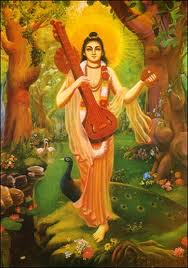NARADA PURANA |
|
 |
King Bharata turned as Jada Bharata who counselled King Souvira about Advaita King Bharata, after whose name was popularized Bharata Varsha, was an exemplary practitioner of Dharma deeply engaged in noble deeds as Yagnas, charities and Tirtha Yatras; after retirement he moved to the Ashram of Pulastya Muni practising Dhyana and devotion. One morning while taking bath in a River, he found a pregnant deer delivered on the banks of the River on hearing the frightening sounds of a tiger and died. Bharata took the baby deer to the Ashram and in course of time became terribly attached to it. |
As Bharata was dying his infatuation for the animal was so much that in the next birth, he was born as a deer as a ‘Jaatismara’ or with the knowledge of previous birth. Even as a deer, it continued the habit of performing Puja by flowers etc. and eventually died and was born into a Brahmana family; when he came of age, he never followed the habits of a disciplined life as other Brahmana boys but whiled away his time attracting unhappiness of his parents and associates, however claiming that he was a deer and King Bharata in his previous births. As everybody felt that he was good for nothing, he acquired the epithet of Jada Bharata. One day, King Souvira of the Kingdom desired to reach the Ashram of Kapila Maha Muni and Jada Bharata was also instructed to carry the palanquin of the King along with other carriers. Since Jada Bharata was not able to carry the palanquin properly, the King shouted on him and said that he was fat, slow, tired and out of step with other carriers. The Brahmana (Jada Bharata) replied that indeed he was neither fat nor tired but that under his feet was Prithvi (Earth), over which were two feet, legs, thighs, stomach, chest, hands and shoulders which were all carrying the King’s body; that the bodies of the King as also that of his own were both made of the same ‘Pancha Bhutas’(Five Elements of Earth, Water, Air, Light and Sky) and were governed by the mix of three ‘Gunas’ (features) of Satvika, Rajasika and Tamasika nature and these Gunas result in the ‘Karmas’(Actions) performed by the Live Beings as per the level of their own Vidya or Avidya (learning capacity or other wise), as also the Maya or illusions of the Self and others ( the ‘Me’and ‘You’), little realising that the ‘Atma’(inner consciousness) was pure and blemishless, everlasting, peaceful, and featureless that was distinctive and different from Prakriti ( Nature); it was that Prakriti which made the differences like one person was fat or lean, smart or dull, etc. On the same analogy, one being might not be able to carry a palanquin properly but another manifestation of the Super Soul viz. Earth might be able to withstand the load of mountains, trees, and seas.The Source-Material was basically one and the same and that was the same Supreme Being! When the Brahmana gave the reply to the King as above, the latter was non-plussed and having got out of the palanquin enquired as to the Brahmana was. The reply was: the words ‘You’ or ‘I’ were the countless forms of the same Super Shakti and were irrelevant and that the placements of each ‘Charaachara’ (Moveable/Immoveable) being in the Creation of Paramatma depended on the basis of one’s own ‘Karma’ or Actions; for eg. Some as Kings and another’s as a beggar. Jada Bharata narrated to the King Souvira the illustration of Brahmana called Nidagha the son of Sage Pulastya and Muni named Rijhu as to how the ramifications of Avidya or Ignorance tended to influence the psyche and deeds of every being. Rijhu as a stranger visited Nidagha at his house once and the latter requested the Muni to indicate where he was from and asked him to have his food; after the food, the Brahmana asked whether the food was it was good. The Muni replied that when a person was hungry or thirsty the food or drink served would indeed satisfy and one need not delve into the nuances of taste, quality, colour etc. as they were not as important as long as the food and drink agreed the body-system; eqally unimportant was as to where did he come from and was going to. Then Muni explained to Nidagha as to what Advaita was all about; that the ‘Jeevatma’ and ‘Paramatma’ were one and the same, that ‘Maya’ or illusion made the distinction of the two, since the body was temporary and subject to destruction; that the pattern of the ephemeral life would get shaped as per the Karma or fate on the basis of the good or bad deeds performed by a being; that the cycle of births and deaths would go on till the Jeevatma in various forms ranging from the most insignificant species to human beings broke the Cycle and reached ‘Mukti’ or Salvation to higher levels of existence than human beings and finally to ‘Paramatma’. |
|
| Narada Purana Home | Next: Six ĹVedangasĺ constitute the means of knowledge to attain ĹMuktiĺ |
Back to the News Page